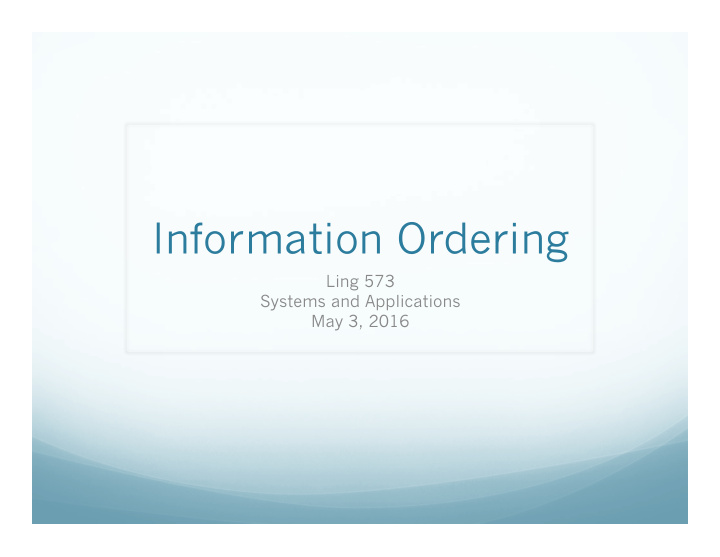



Information Ordering Ling 573 Systems and Applications May 3, 2016
Roadmap Ordering models: Chronology and topic structure Mixture of experts Preference ranking: Chronology, topic similarity, succession/precedence Entity-based cohesion Entity transitions Coreference, syntax, and salience
Improving Ordering Improve some set of chronology, cohesion, coherence Chronology, cohesion (Barzilay et al, ‘02) Key ideas: Summarization and chronology over “themes” Identifying cohesive blocks within articles Combining constraints for cohesion within time structure
Importance of Ordering Analyzed DUC summaries scoring poor on ordering Manually reordered existing sentences to improve Human judges scored both sets: Incomprehensible, Somewhat Comprehensible, Comp. Manual reorderings judged: As good or better than originals Argues that people are sensitive to ordering, ordering can improve assessment
Framework Build on their existing systems (Multigen) Motivated by issues of similarity and difference Managing redundancy and contradiction in docs Analysis groups sentences into “themes” Text units from diff’t docs with repeated information Roughly clusters of sentences with similar content Intersection of their information is summarized Ordering is done on this selected content
Chronological Orderings I Two basic strategies explored: CO: Need to assign dates to themes for ordering Theme sentences from multiple docs, lots of dup content Temporal relation extraction is hard, try simple sub. Doc publication date: what about duplicates? Theme date: earliest pub date for theme sentence Order themes by date If different themes have same date? Same article, so use article order Slightly more sophisticated than simplest model
Chronological Orderings II MO (Majority Ordering): Alternative approach to ordering themes Order the whole themes relative to each other i.e. Th1 precedes Th2 How? If all sentences in Th1 before all sentences in Th2? Easy: Th1 b/f Th2 If not? Majority rule Problematic b/c not guaranteed transitive Create an ordering by modified topological sort over graph Nodes are themes: Weight: sum of outgoing edges minus sum of incoming edges Edges E(x,y): precedence, weighted by # texts where sentences in x precede those in y
CO vs MO Neither of these is particularly good: Poor Fair Good MO 3 14 8 CO 10 8 7 MO works when presentation order consistent When inconsistent, produces own brand new order CO problematic on: Themes that aren’t tied to document order E.g. quotes about reactions to events Multiple topics not constrained by chronology
New Approach Experiments on sentence ordering by subjects Many possible orderings but far from random Blocks of sentences group together (cohere) Combine chronology with cohesion Order chronologically, but group similar themes Perform topic segmentation on original texts Themes “related” if, when two themes appear in same text, they frequently appear in same segment (threshold) Order over groups of themes by CO, Then order within groups by CO Significantly better!
Before and After
Integrating Ordering Preferences Learning Ordering Preferences (Bollegala et al, 2012) Key idea: Information ordering involves multiple influences Can be viewed as soft preferences Combine via multiple experts: Chronology Sequence probability Topicality Precedence/Succession
Basic Framework Combination of experts Build one expert for each of diff’t preferences Take a pair of sentences (a,b) and partial summary Score > 0.5 if prefer a before b Score < 0.5 if prefer b before a Learn weights for linear combination Use greedy algorithm to produce final order
Chronology Expert Implements the simple chronology model If sentences from two different docs w/diff’t times Order by document timestamp If sentences from same document Order by document order Otherwise, no preference
Topicality Expert Same motivation as Barzilay 2002 Example: The earthquake crushed cars, damaged hundreds of houses, and terrified people for hundreds of kilometers around. A major earthquake measuring 7.7 on the Richter scale rocked north Chile Wednesday. Authorities said two women, one aged 88 and the other 54, died when they were crushed under the collapsing walls. 2 > 1 > 3
Topicality Expert Idea: Prefer sentence about the “current” topic Implementation:? Prefer sentence with highest similarity to sentence in summary so far Similarity computation:? Cosine similarity b/t current & summary sentence Stopwords removed; nouns, verbs lemmatized; binary
Precedence/Succession Experts Idea: Does current sentence look like blocks preceding/ following current summary sentences in their original documents? Implementation: For each summary sentence, compute similarity of current sentence w/most similar pre/post in original doc Similarity?: cosine PREF pre (u,v,Q)= 0.5 if [Q=null] or [pre(u)=pre(v)] 1.0 if [Q!=null] and [pre(u)>pre(v)] 0 otherwise Symmetrically for post
Sketch
Probabilistic Sequence Intuition: Probability of summary is the probability of sequence of sentences in it, assumed Markov P(summary)= Π P(S i |S I-1 ) Issue: Sparsity: will we actually see identical pairs in training? Repeatedly backoff: To N, V pairs in ordered sentences To backoff smoothing + Katz
Results & Weights Trained weighting using a boosting method Combined: Learning approach significantly outperforms random, prob Somewhat better that raw chronology Expert Weight Succession 0.44 Chronology 0.33 Precedence 0.20 Topic 0.016 Prob. Seq. 0.00004
Observations Nice ideas: Combining multiple sources of ordering preference Weight-based integration Issues: Sparseness everywhere Ubiquitous word-level cosine similarity Probabilistic models Score handling
Recommend
More recommend